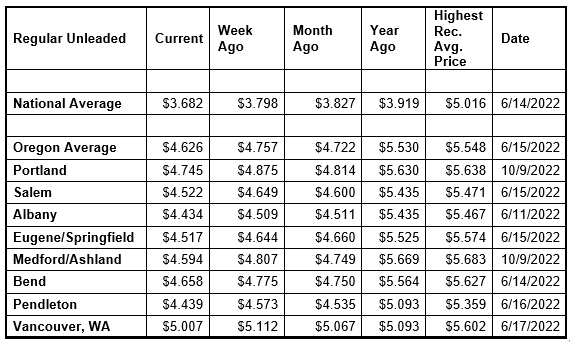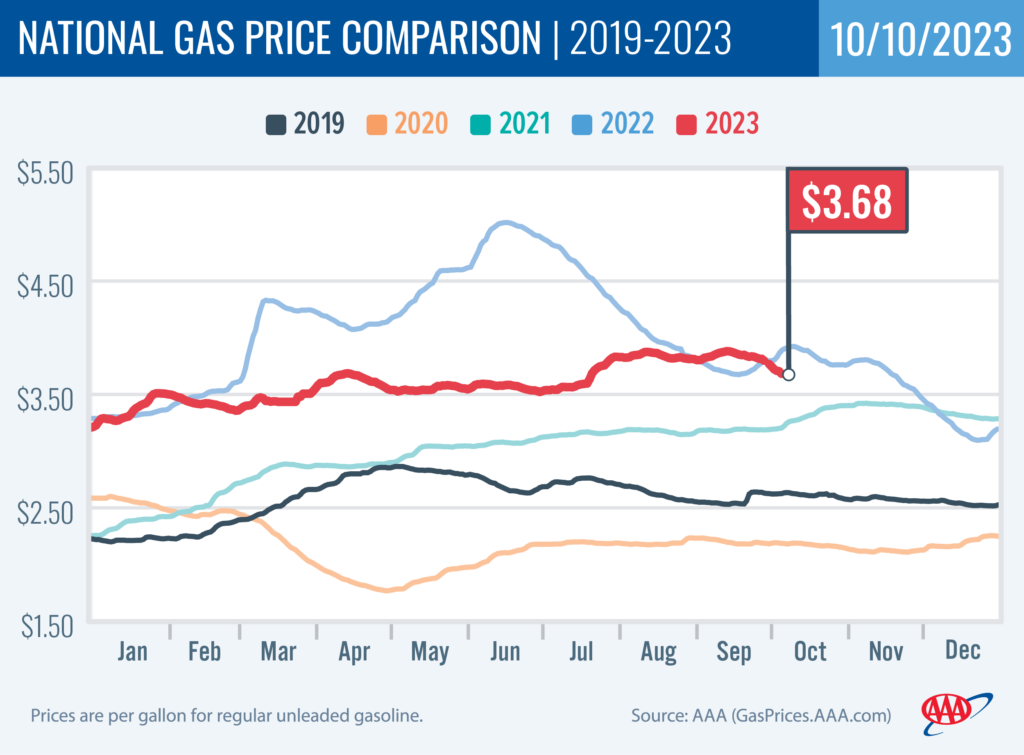However, the Israel-Hamas war could derail declines at the pumps
PORTLAND, Ore., – The declines in pump prices we normally see in the fall are finally here. Gas prices are lower in all 50 states with 24 states, including Oregon, seeing their averages fall by double digits. However, concerns about the attack on Israel and whether the unrest could spread and lead to an unstable Middle East have the potential to send crude oil prices higher. For the week, the national average loses 12 cents to $3.68. The Oregon average tumbles 13 cents to $4.63.

“Crude oil prices rose to start this week, due to the horrific attacks on Israel and the potential impacts to the Middle East region, which is a major oil producer. Crude prices had plunged last week on concerns that the Federal Reserve will again need to raise interest rates. If crude oil prices again climb above $90 per barrel or higher, gas prices will remain elevated,” says Marie Dodds, public affairs director for AAA Oregon/Idaho.
Gas prices normally decline in the fall, in part due to the switch from summer-blend gas to winter-blend gas. Winter-blend gas is cheaper to produce than summer-blend fuel as it contains ingredients such as butane, so gas prices normally fall when the switch occurs. Summer-blend gas helps reduce emissions from gasoline during the warm summer months. More info on summer- and winter-blend gasoline can be found at the EPA website. The switch occurs on September 15 except California, which normally keeps summer-blend gasoline until October 31. This year, California has allowed the switch to occur earlier because of refinery issues in that state that sent pump prices soaring on the West Coast two weeks ago.
Crude oil prices surged above $90 per barrel in mid-September, the highest price since last November, in response to the announcement from Saudi Arabia and Russia that they would keep their production cuts in place through 2023. The cuts are one million barrels a day by Saudi Arabia and 300,000 barrels a day by Russia.
Crude oil is trading around $85 today compared to $90 a week ago and $91 a year ago. In September, West Coast Intermediate ranged between about $85 and $94 per barrel. In August, WTI ranged between about $77 and $85 per barrel. In July, West Texas Intermediate ranged between about $69 and $82 per barrel. In June, WTI ranged between about $67 and $73 per barrel. In May, WTI ranged between about $63 and $77 per barrel. In April, WTI ranged between about $73 and $83. In March, WTI ranged between about $64 and $81 per barrel. In February, WTI ranged between about $73 and $80 per barrel. In January, WTI ranged between about $73 and $82 bbl. Crude reached recent highs of $123.70 on March 8, 2022, shortly after the Russian invasion of Ukraine, and $122.11 per barrel on June 8, 2022. The all-time high for WTI crude oil is $147.27 in July 2008.
Crude oil is the main ingredient in gasoline and diesel, so pump prices are impacted by crude prices on the global markets. On average, about 50% of what we pay for in a gallon of gasoline is for the price of crude oil, 25% is refining, 11% distribution and marketing, and 14% are taxes, according to the U.S. Energy Information Administration.
Demand for gasoline dropped significantly from 8.62 to 8.01 million b/d for the week ending September 29, according to the U.S. Energy Information Administration (EIA). This compares to 9.47 million b/d a year ago. Meanwhile, total domestic gasoline stocks increased substantially by 6.5 million bbl to 227 million bbl. Growing supply, amid low demand, has pushed pump prices down. If oil prices continue to decline, drivers can expect further price drops at the pump in the weeks ahead. However, concerns about the Middle East region could keep crude prices elevated.
Quick stats
All 50 states have lower prices now than a week ago with 24 states, including Oregon, seeing double-digit drops. California (-26 cents), Nevada (-22 cents) and Arizona (-17 cents) have the biggest weekly declines. Hawaii (-4 cents) and New York (-4 cents) have the smallest.
California ($5.77) has the most expensive gas in the nation for the 11th week in a row. California’s average is back in the $5-dollar range after spending one week above $6 per gallon. Washington ($5.00) is second. These are the two states with averages at or above $5 a gallon. Nevada ($4.89) is third, Hawaii ($4.84) is fourth, Oregon ($4.63) is fifth, Alaska ($4.59) is sixth, Arizona ($4.47) is seventh, Idaho ($4.05) is eighth, and Utah ($4.02) is ninth. Last week, there were 10 states with averages at or above $4 a gallon. This week 41 states and the District of Columbia have averages in the $3-range. No state has an average in the $2 range this week.
The cheapest gas in the nation is in Georgia ($3.13) and Mississippi ($3.14). For the 143rd week in a row, no state has an average below $2 a gallon.
The difference between the most expensive and least expensive states is $2.63 this week, compared to $2.80 a week ago.
Oregon is one of 46 states and the District of Columbia with lower prices now than a month ago. The national average is 15 cents less and the Oregon average is 10 cents less than a month ago. Iowa (-54 cents) has the largest monthly drop. California (+34 cents) has the largest monthly jump.
Oregon is one of 42 states and the District of Columbia with lower prices now than a year ago. The national average is 24 cents less and the Oregon average is 90 cents less than a year ago. This is the second-largest yearly drop in the nation. Alaska (-96 cents) has the largest yearly decrease. Connecticut (+29 cents) has the largest year-over-year increase.
West Coast
The West Coast region continues to have the most expensive pump prices in the nation with all seven states in the top 10. It’s typical for the West Coast to have six or seven states in the top 10 as this region tends to consistently have fairly tight supplies, consuming about as much gasoline as is produced. In addition, this region is located relatively far from parts of the country where oil drilling, production and refining occurs, so transportation costs are higher. And environmental programs in this region add to the cost of production, storage and distribution.
| Rank | Region | Price on 10/10/23 |
| 1 | California | $5.77 |
| 2 | Washington | $5.00 |
| 3 | Nevada | $4.89 |
| 4 | Hawaii | $4.84 |
| 5 | Oregon | $4.63 |
| 6 | Alaska | $4.59 |
| 7 | Arizona | $4.47 |
| 8 | Idaho | $4.05 |
| 9 | Utah | $4.02 |
| 10 | Montana | $3.99 |
As mentioned above, California has the most expensive gas in the country. Washington, Nevada, Hawaii, Oregon, Alaska, and Arizona round out the top seven. Oregon is fifth for the fourth consecutive week.
Like the rest of the country, all states in the West Coast region are seeing week-over-week declines. California (-26 cents), Nevada (-22 cents) and Arizona (-17 cents) have the largest weekly drops in the region and the nation. Washington (-13 cents), Oregon (-13 cents), Alaska (-4 cents), and Hawaii (-4 cents) are also seeing weekly declines.
The refinery utilization rate on the West Coast rose from 88.0% to 92.6% for the week ending September 29. This rate has ranged between about 73% to 96% in the last year. The latest national refinery utilization rate decreased from 89.5% to 87.3%.
According to EIA’s latest weekly report, total gas stocks in the region increased from 28.08 million bbl. to 29.34 million bbl.
A higher refinery utilization rate and an increase in gasoline stocks can put downward pressure on pump prices.
Oil market dynamics
Crude oil prices rose to start this week, on concerns that the attack on Israel by Hamas could lead to destabilization of the Middle East region, which could lead to reduced oil production. Crude oil prices fell sharply last week due to rising market concern that if interest rates continue to increase, the economy could tip into a recession. If a recession occurs, crude demand and prices would likely drop. Additionally, the EIA reported that total commercial crude stocks decreased by 2.2 million bbl to 414.1 million bbl last week.
At the close of Friday’s formal trading session, WTI rose $1.43 to settle at $82.79. At the close of Monday’s formal trading session, WTI rose $3.59 to settle at $86.38. Today crude is trading around $85 compared to $90 a week ago. Crude prices are about $6 less more than a year ago.
Drivers can find current gas prices along their route with the free AAA Mobile app for iPhone, iPad and Android. The app can also be used to map a route, find discounts, book a hotel and access AAA roadside assistance. Learn more at AAA.com/mobile.

Diesel
For the week, the national average loses five cents to $4.51 a gallon. The record high is $5.816 set on June 19, 2022. The Oregon average falls seven cents to $5.10. The record high is $6.47 set on July 3, 2022. A year ago the national average for diesel was $5.06 and the Oregon average was $5.60.
Find current fuel prices at GasPrices.AAA.com.
AAA news releases, high resolution images, broadcast-quality video, fact sheets and podcasts are available on the AAA NewsRoom at NewsRoom.AAA.com.
Find local news releases at https://oregon.aaa.com/community/media/media-contacts.html
Fuel prices are updated daily at AAA’s Daily Fuel Gauge at AAA Gas Prices. For more info go www.AAA.com. AAA Oregon/Idaho provides more than 890,000 members with travel, insurance, financial and automotive-related services, and is an affiliate of AAA National, serving more than 63 million motorists in North America.

